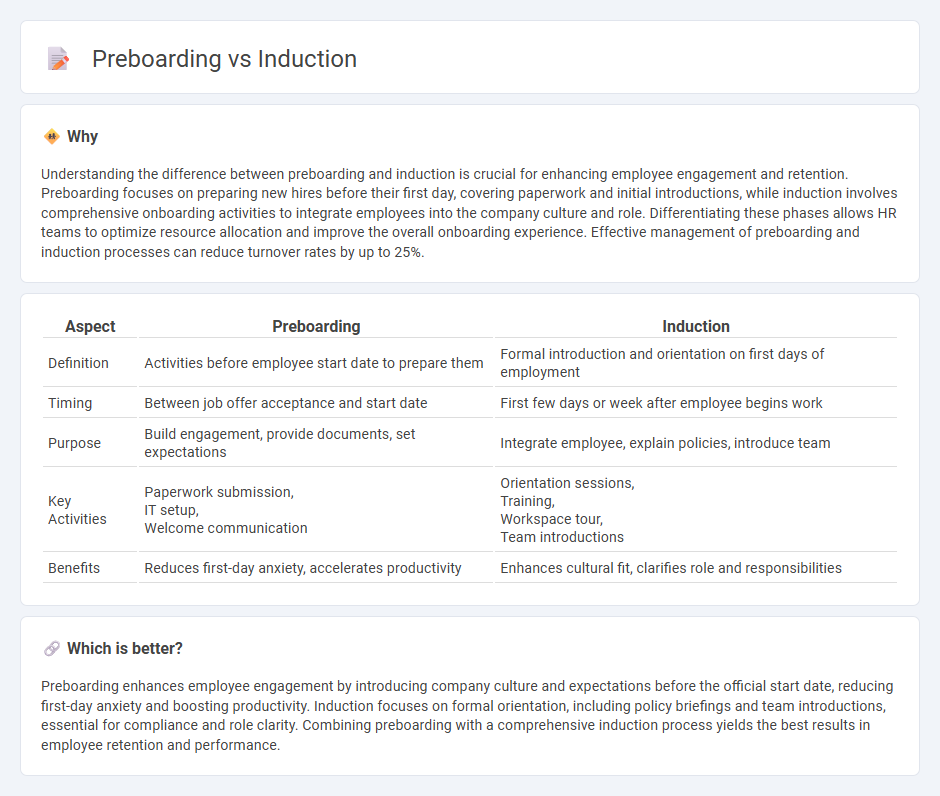
Preboarding involves the activities and communication that occur between a candidate's acceptance of a job offer and their first day at work, focusing on documentation, workspace setup, and initial engagement to ensure a smooth transition. Induction, also called onboarding, starts on the employee's first day, concentrating on orientation, training, integration into the company culture, and role-specific guidance to enhance productivity and retention. Explore further the strategic differences between preboarding and induction to optimize employee experience and organizational outcomes.
Why it is important
Understanding the difference between preboarding and induction is crucial for enhancing employee engagement and retention. Preboarding focuses on preparing new hires before their first day, covering paperwork and initial introductions, while induction involves comprehensive onboarding activities to integrate employees into the company culture and role. Differentiating these phases allows HR teams to optimize resource allocation and improve the overall onboarding experience. Effective management of preboarding and induction processes can reduce turnover rates by up to 25%.
Comparison Table
| Aspect | Preboarding | Induction |
|---|---|---|
| Definition | Activities before employee start date to prepare them | Formal introduction and orientation on first days of employment |
| Timing | Between job offer acceptance and start date | First few days or week after employee begins work |
| Purpose | Build engagement, provide documents, set expectations | Integrate employee, explain policies, introduce team |
| Key Activities |
Paperwork submission, IT setup, Welcome communication |
Orientation sessions, Training, Workspace tour, Team introductions |
| Benefits | Reduces first-day anxiety, accelerates productivity | Enhances cultural fit, clarifies role and responsibilities |
Which is better?
Preboarding enhances employee engagement by introducing company culture and expectations before the official start date, reducing first-day anxiety and boosting productivity. Induction focuses on formal orientation, including policy briefings and team introductions, essential for compliance and role clarity. Combining preboarding with a comprehensive induction process yields the best results in employee retention and performance.
Connection
Preboarding and induction are connected by their shared goal of integrating new employees effectively into an organization. Preboarding initiates engagement before the first day by providing essential information and resources, while induction formalizes orientation with training and cultural assimilation. Together, they enhance employee readiness, reduce turnover, and accelerate productivity.
Key Terms
Onboarding
Induction is a formal process that introduces new employees to company culture, policies, and their roles, typically conducted on the first day. Preboarding occurs between offer acceptance and the start date, aiming to engage and prepare employees with essential information and paperwork. Explore more to understand how effective onboarding strategies boost employee retention and productivity.
Orientation
Induction and preboarding both play crucial roles in employee orientation, with preboarding focusing on engaging new hires before their official start date by providing essential company information, paperwork, and access to resources. Induction occurs on the first day or shortly after, offering a comprehensive introduction to company culture, policies, team members, and job-specific training to facilitate a smooth transition. Discover more about how effective orientation strategies can boost employee retention and performance.
Cultural Assimilation
Induction programs primarily focus on introducing new employees to company policies, roles, and responsibilities, whereas preboarding emphasizes early cultural assimilation by engaging hires with organizational values and social norms before their official start date. Effective cultural assimilation during preboarding leads to higher employee engagement, reduced turnover, and faster integration into teams. Discover more about optimizing your onboarding process to enhance cultural assimilation and employee retention.
Source and External Links
What Is Induction Cooking and How Does It Work? - Induction cooktops use electromagnetic energy to directly heat compatible cookware, offering faster temperature changes and greater energy efficiency compared to traditional electric or gas cooktops.
What is an Induction Cooktop and How Does it Work? - An induction cooktop generates a magnetic field that induces electrical currents in compatible pots and pans, turning them into their own heat source for rapid heating and cooling.
What Is an Induction Cooktop? 5 Benefits to Consider - Induction cooktops heat cookware using electromagnetism, making them highly efficient and capable of boiling water much faster than conventional electric or gas stoves.
 dowidth.com
dowidth.com